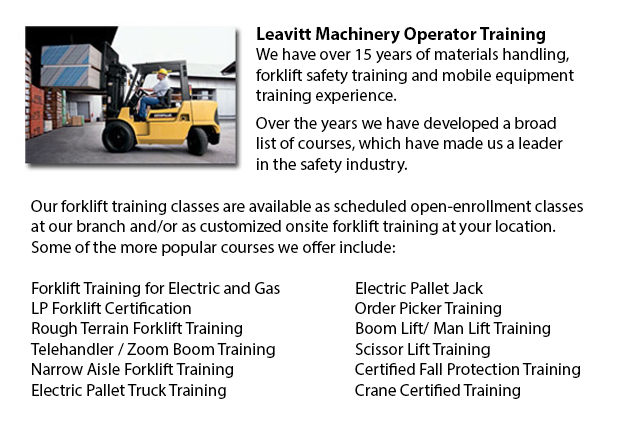
Prince George Forklift Training Schools - Have An Efficient And Safe Work Area With Our Forklift Training Schools
If you are searching for a job as an operator of a forklift, our regulatory-compliant lift truck training Schools provide excellent instruction in various styles and types of forklifts, lessons on pre-shift inspection, fuel types and handling of fuels, and safe utilization of a lift truck. Practical, hands-on training assists those participating in obtaining essential operational skills. Course content comprises current rules governing the utilization of lift trucks. Our proven forklift courses are intended to provide training on these kinds of trucks: narrow isle forklift, counterbalanced forklift and powered pallet truck.
Do not raise or lower the fork whilst the lift truck is moving. A load should not extend over the backrest due to the risk of the load sliding back in the direction of the operator. Inspect for overhead obstructions and make certain there is adequate clearance prior to lifting a load. Stay away from overhead power lines. Once the load is raised straight up, tilt it back slightly.
The lift truck is less stable when a load is in a raised position. Make certain that no body ever walks below the elevated fork. The operator must never leave the lift truck when the load is raised.
While handling pallets, forks must be level and high enough to go into the pallet and extend all the way under the load. The fork's width should provide even distribution of weight.
Set the brakes and chock the wheels before loading and unloading the truck. The floors should be strong enough to support the combined weight of the load and the forklift. Fixed jacks can be installed to support a semi-trailer which is not attached to a tractor. The height of the entrance door must clear the forklift height by at least 5 cm. Mark edges of ramps, docks or rail cars and avoid them.
-
Prince George Telehandler Operator Training
Prince George Telehandler Operator Training - Telehandler forklifts or Telescopic Handler forklifts are common industrial machines found in various construction industry settings. The telehandler is a useful machinery and makes for a valuable tool wh... More -
Skid Steer Loader Certification in Prince George
The engine powered skid-steer loader comprises a small and rigid frame, equipped with lift arms that could attach to many industrial attachments and tools to execute several labor saving tasks. Normally, skid-steer loaders are four-wheel drive vehicl... More -
Prince George Telehandler License
Prince George Telehandler License - The telescopic handler or telehandler is a generally utilized machine in agricultural and industrial applications. This machine is the same in look to a forklift and also works in a similar manner, although telehan... More -
Prince George Manlift Ticket
Prince George Manlift Ticket - The Elevated Platforms and Manlifts Certification course helps to provide the needed training on the work practices, safe operating procedures, rules and regulations regarding the everyday activities for the operators o... More -
Prince George Manlift Operator Training
Prince George Manlift Operator Training - A specialized kind of hydraulic platform is referred to as an aerial lift or a man lift. It is designed to hoist an individual vertically up and down and thus, is likewise called a vertical personnel lift. Th... More -
Prince George Forklift Safety Training
Prince George Forklift Safety Training - Individuals wanting work in industries that utilize forklifts have to undergo a forklift safety training course prior to becoming a certified operator of a lift truck. There are many ways to go about obtaining... More -
Prince George Boom Lift Certification
Prince George Boom Lift Certification - The use o elevated work platforms allow for maintenance operations and work to be performed at elevated work heights which were otherwise unreachable. Workers making use of boom lifts and scissor lifts could be... More -
Prince George Crane Training Schools
Prince George Crane Training Schools - We have designed various programs for Mobile Crane Operation at our Crane Training Schools. These programs are recommended for the skilled operator who needs certification or re-certification, and for inexperien... More

Forklift Certification Prince George
TOLL FREE: 1-888-254-6157
Prince George, British Columbia
forkliftcertificationprincegeorge.com
Email Us
About Us


